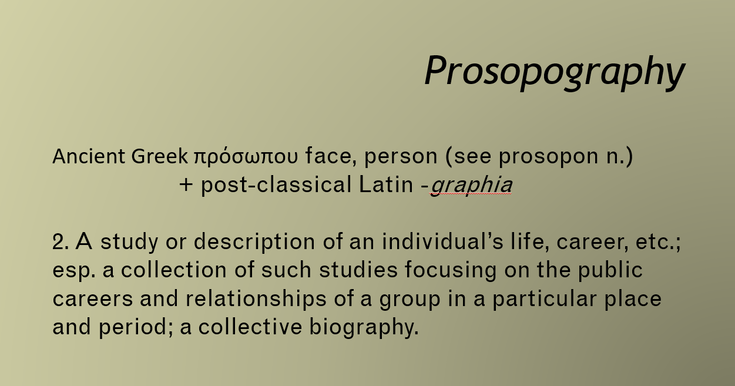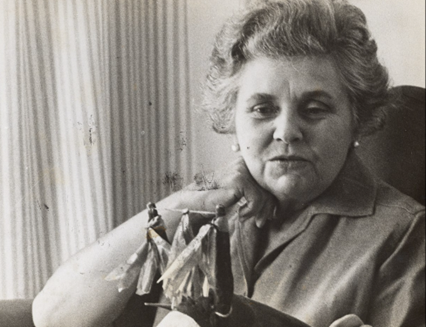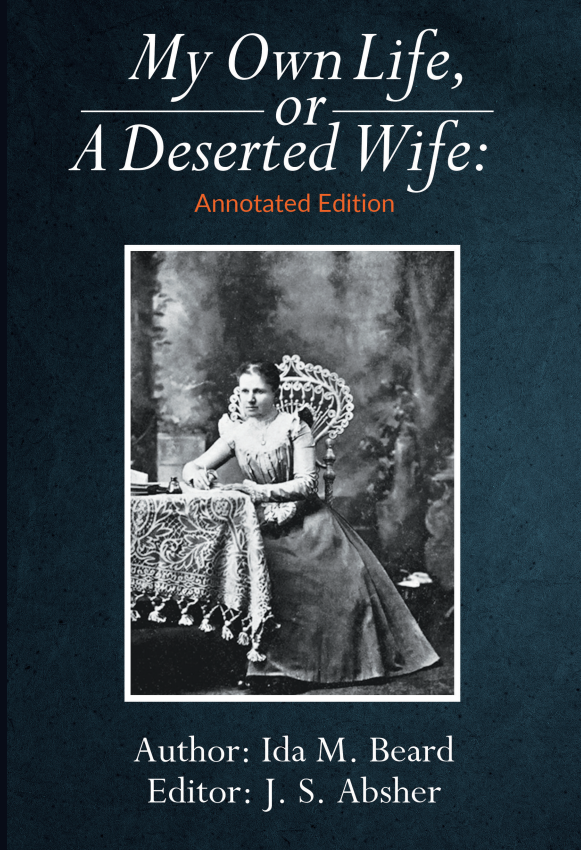 Source: http://www.oed.com/view/Entry/`153010 The Method and Value of Prosopography
In August 1895, rumors of an imminent lynching swept the white and black communities of Winston-Salem, North Carolina. Probably in response to a call for action at the end of a Sunday evening church service, a large group of armed African Americans went to guard the jail and protect he prisoner in question, young Arthur Tuttle. As I will explain in detail in the next post or two, Tuttle had killed a policeman on the street a few months before. When the crowd did not disperse, the local militia and sheriff deputies gathered, someone fired a shot, then the firing became general. The crowd scattered, with an unknown number wounded and possibly killed. Approximately fifty African American men were arrested, many of whom were tried and convicted, with sentences ranging from a year at hard labor on the county roads to payment of court costs. Their names were published in the local newspapers. In reading accounts of the riot, as it was called, I became interested in the fifty men: who were they? What were their family backgrounds, their trades and professions, their connections with each other? Which churches did they belong to? What were their political aspirations? One of the rioters, an older man called Cager Watt, was said by the newspapers to be a ringleader, and I wondered if there were a way to support or debunk that claim. Were there other likely leaders in the group? So far as I have discovered, there are no surviving first person accounts from participants in the riot—no diaries, letters, memoirs, or photographs. [Update, 18 Aug 2022: In the 1970s, some eyewitnesses were interviewed; their accounts are reflected in the 1981 dissertation by Bertha Hampton Miller, "Blacks in Winston-Salem, North Carolina 1895-1920."] To draw the group’s portrait, I must rely on the information that can be gleaned from newspapers, city directories, genealogical records, vital records, etc. In 1971, Lawrence Stone defined prosopography (collective biography) as “the investigation of the common background characteristics of a group of actors in history by means of a collective study of their lives. The method employed is to establish a universe to be studied, and then to ask a set of uniform questions—about birth and death, marriage and family, social origins and inherited economic position, place of residence, education, amount and source of personal wealth, occupation, religion, experience of office, and so on.” It works best when “applied to easily defined and fairly small groups over a limited period” for which there are many sources. (“Prospography,” Daedalus 100:1, 46-79). A major question will be whether the sources are adequate for my purposes. Before Stone’s essay, the discipline had been applied by Lewis Namier in his groundbreaking studies of British parliamentarians. Since then, digital tools—databases, visualization tools, etc.—have been devised to help construct and analyze social networks across a wide array of times and places. One example among many is the Prosopography of the Byzantine Empire (http://www.pbe.kcl.ac.uk/). My techniques are old-fashioned and slow and my ambitions are on a far smaller scale. I am an amateur getting started rather late in life. But I hope to make a contribution that will be useful to more sophisticated and energetic researchers. The larger question under examination is the nature of African American political life between Reconstruction and Jim Crow, a period that I believe has been somewhat neglected by historians. Next posts: “The Tuttle Family and the Riot of 1895.” Would you like to support my work? Buy my books! Please send comments to [email protected].
0 Comments
In my annotated edition of a 19th-century memoir, My Own Life, or A Deserted Wife, I found it necessary to research the identity of the many people mentioned by the memoirist, Ida Crumpler Beard, as well as others involved in the events she recounts. My main sources were contemporary newspapers (digitized on newspapers.com), city directories, various other published sources, and the vital records and genealogical information on FamilySearch.org and Ancestry.com. Appendix E, “Index to People, with Biographical Sketches,” summarizes this research through approximately 200 biographical sketches. Since Ida spent most of her life in Winston-Salem, most of the sketches concern people who lived there between 1862, when Ida was born, and 1898, when she published her memoir.
These sketches provide information on the lives of men and women, both white and black, at various levels of society. But the treatment is uneven. In that period, there were no known newspapers in town owned or edited by African Americans; so far as I know, the first was the short-lived Twin-City Herald, founded and edited by the Rev. Jethro T. Gibbons in 1898. The extant newspapers from the period were all owned and edited by white men. The Union Republican was founded and edited by Junius W. Goslen as a voice for the Union Republican party, “an interracial political party devoted to the principles of freedom, civil equality, and workers’ rights for all people, including the newly freed slaves. … Republicans endorsed political privileges for all men regardless of race or economic conditions” (Deborah Becket, Radical Reform: Interracial Politics in Post-Emancipation North Carolina, The American South Series, ebook, xvi, 158). Goslen was a political ally of local African Americans, but they often felt his support was insufficient, particularly when it came to their aspirations to higher level elected positions and patronage positions. Goslen’s competition was The Western Sentinel and various related papers; they supported what they called “the Democracy,” that is, rule by white men in the Democratic party. They had supported secession and now openly supported white supremacy. However, The Western Sentinel could not simply ignore African Americans: the men could vote and were often elected to the town council from 1880-1896, an era that ended in 1898 with the statewide white supremacy campaign, followed by Jim Crow constitutional changes in 1900. The treatment by both papers may have been biased, sometimes vicious, but we can discern many of the leaders and politically active citizens in the African American community and at least some of their political goals. However, all the African American leaders I have identified through the newspapers were men. My biographical sketches include only a single African American woman, Miranda Ratcliff, who had nursed Ida from birth. African American women are conspicuously absent from the pages of the local newspapers. They will continue to be largely absent from the collective biography on which I am currently engaged, a study of the fifty African American men who were arrested in 1895 as they attempted to protect a young man, Arthur Tuttle, from being lynched. The lynching never occurred, but many of these men were sentenced to hard labor or fines. In this project, I hope to discover who these men were, their connections with each other, their family connections (including wives and mothers), their trades and professions, their religious and social affiliations—the stuff of the collective biographical discipline called prosopography. Forthcoming posts include “The Method and Value of Prosopography” and “The Tuttle Family and the Riot of 1895.” Would you like to support my work? Buy my books! Send comments to [email protected].  Elizabeth Bishop in Brazil in 1964. Public domain (source: https://en.wikipedia.org/wiki/Elizabeth_Bishop#/media/File:Elizabeth_Bishop,_1964.jpg) People sometimes ask where an artist’s ideas come from. It’s a hard question to answer; “it depends” is probably the most accurate answer, though hardly illuminating to the questioner.
On a few blessed occasions, the answer is, “from everywhere.” I like this comment from a letter by Elizabeth Bishop to her friend, Robert Lowell: Your poems “have that sure feeling, as if you’d been in a stretch … when everything and anything suddenly seemed material for poetry—or not material, seemed to be poetry, and all the past was illuminated in long shafts here and there, like a long-waited-for sunrise. If only one could see everything that way all the time! It seems to me it’s the whole purpose of art, to the artist (not to the audience)—that rare feeling of control, illumination—life is all right, for the time being.” (Elizabeth Spires, "One life, one art: Elizabeth Bishop in her letters,” https://newcriterion.com/issues/1994/5/one-life-one-art-elizabeth-bishop-in-her-letters) An amusing side note comes from Cole Porter’s many stories explaining the origins of “Night and Day” (see William McBrien, Cole Porter, 1998). I’ve captured his various accounts, with poetic license, in my poem, “Theories of Origin,” recently published in Skating Rough Ground: Theories of Origin Zanzibar, ’35-- a little hotel, a patio, ivory dealers in burnouses, the barkeep simpatico, a round on the house, night and day the phonograph playing Night & Day while Porter’s in the corner saying I wrote that in a taxi in the roar of the traffic-- no, at lunch with the Astor’s in Newport, when it was raining drip drip drip—but no, it wasn’t so prosaic-- I took the wife (no, lover) to the starry mosaic vault of a mausoleum-- no no no, it was the plaintive cry of the muezzin from a mosque in Morocco-- and no it doesn’t matter darling where it was on the Black Sea or a bus’s backseat—doesn’t matter if in a bar in Zanzibar or on far out Antares or in patent dancing shoes under a nightclub moon. That’s the best answer perhaps—it doesn’t matter. |
AuthorWrite something about yourself. No need to be fancy, just an overview. Archives
July 2024
Categories |

 RSS Feed
RSS Feed